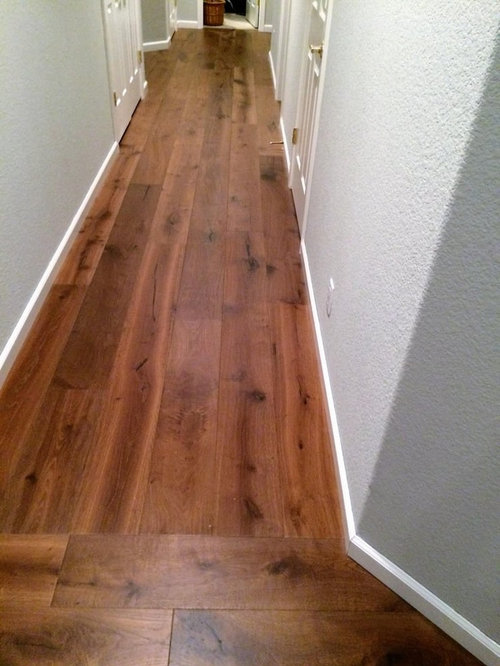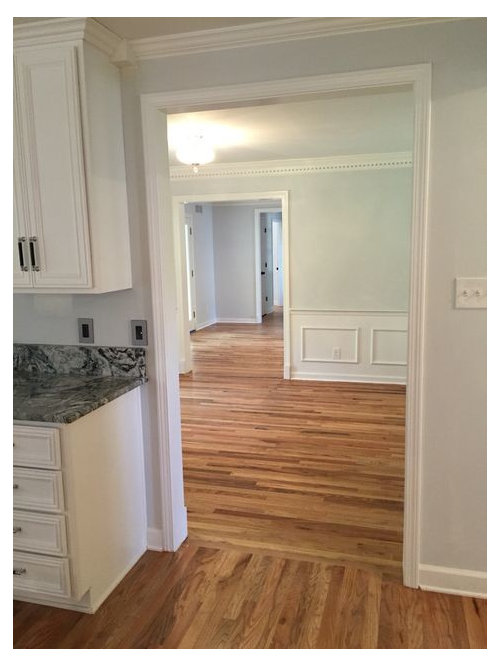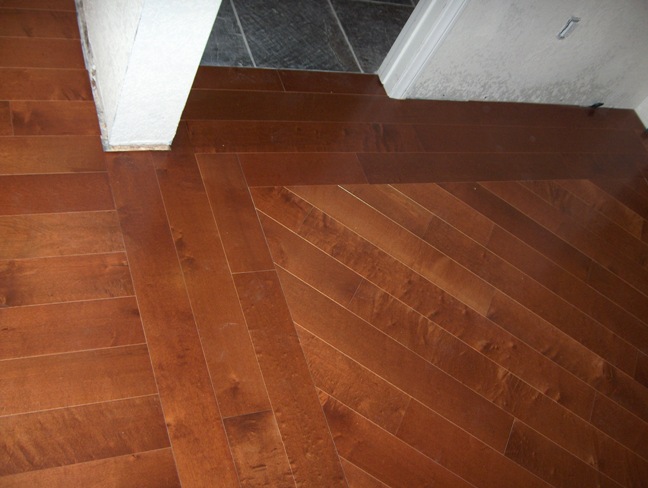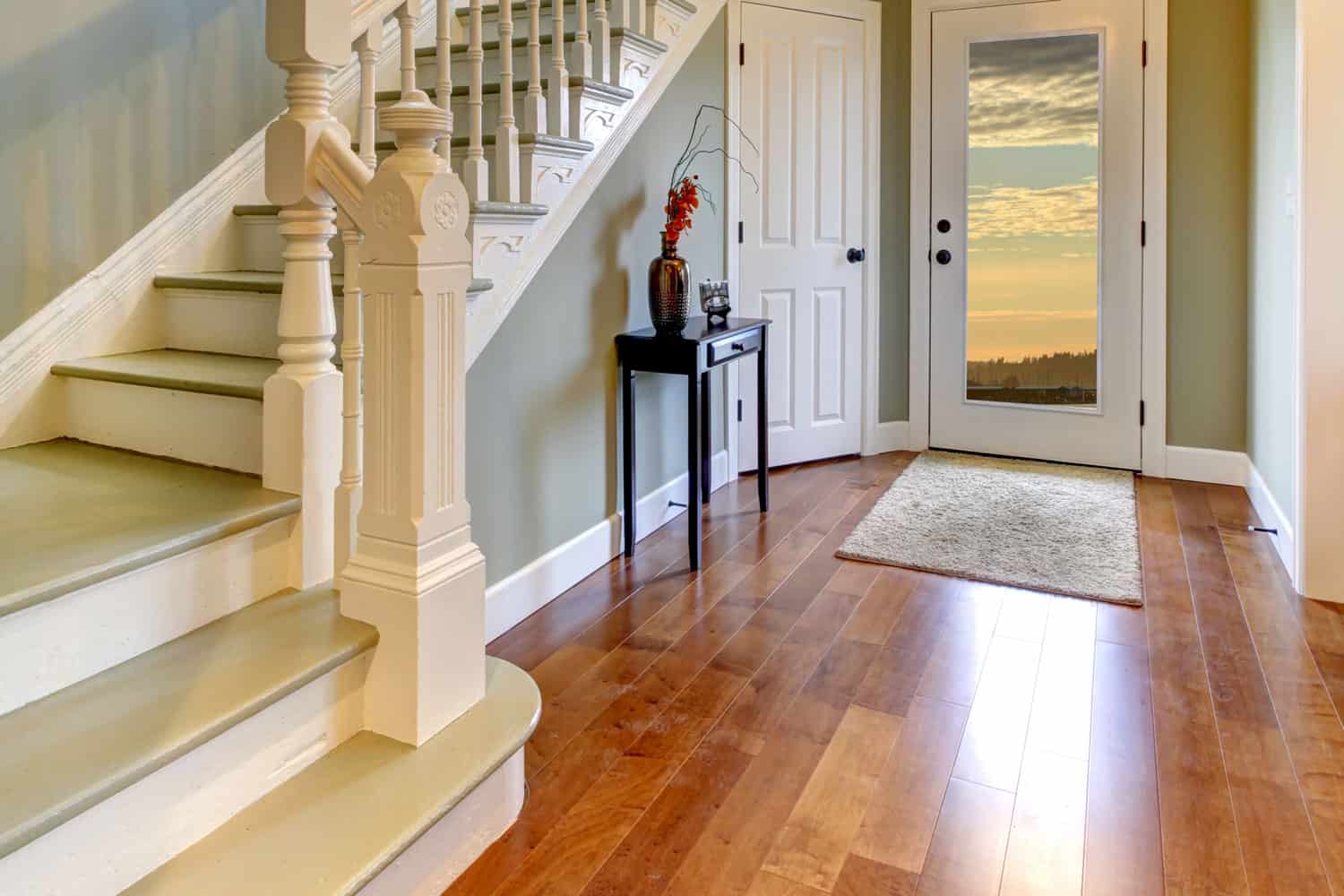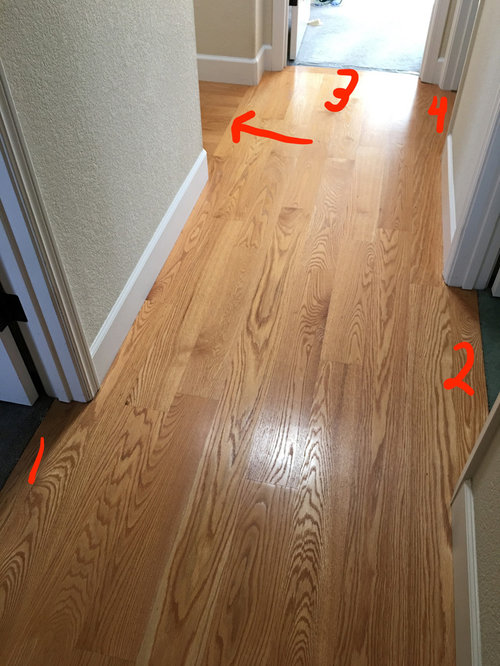The Impact of Wood Flooring Direction in Hallways
Wood flooring direction plays a crucial role in the overall aesthetic and practicality of hallways. The direction in which the wood planks are installed can significantly impact the visual appeal and functionality of the space. We will explore the various factors to consider when choosing the wood flooring direction for your hallway.
- Visual Appeal: The direction of the wood flooring can greatly affect the visual appeal of the hallway. Installing the planks parallel to the longer walls of the hallway tends to create a more traditional and classic look. This direction can also make the space appear longer and more spacious. On the other hand, installing the planks perpendicular to the longer walls can add a modern and contemporary touch to the hallway.
- Flow and Continuity: Another important aspect to consider when deciding on the wood flooring direction is the flow and continuity between different rooms. If you have an open floor plan or adjacent rooms with wood flooring, it is advisable to maintain a consistent direction throughout the space. This creates a seamless transition and enhances the overall design cohesion.
- Practical Considerations: Apart from the visual appeal, practicality is also a significant factor to consider. The wood flooring direction can affect the wear and tear of the floor. Installing the planks perpendicular to the main traffic flow can help minimize the visibility of scratches and dents. This is particularly important in high-traffic areas, such as hallways, where foot traffic is constant.
- Room Size and Shape: The size and shape of the hallway should also be taken into account when deciding on the wood flooring direction. In narrow hallways, installing the planks parallel to the longer walls can create an illusion of width and make the space appear more open. Conversely, in wider hallways, installing the planks perpendicular to the longer walls can add visual interest and break up the expanse of the floor.
- Design Flexibility: One of the advantages of wood flooring is its versatility. The direction of the wood planks can be used to create various design effects. For example, installing the planks diagonally can add a sense of movement and dynamism to the hallway. This direction can also create a unique and visually striking pattern that adds character to the space.
- Maintenance and Cleaning: Lastly, the wood flooring direction can also impact the maintenance and cleaning of the hallway floor. Depending on the direction, dust and dirt may accumulate differently. It is important to consider which direction will be easier to clean and maintain in the long run.

Choosing the Right Wood Flooring Direction for Your Hallway
When it comes to choosing the right wood flooring direction for your hallway, several tips and guidelines can help you make an informed decision. The direction of the wood planks can have a significant impact on the overall look and feel of the space. Here are some key considerations to keep in mind when selecting the wood flooring direction for your hallway.
Consider the Entrance: One important factor to consider is the direction of the entrance to the hallway. It is generally recommended to install the wood flooring perpendicular to the entrance direction. This creates a visually appealing welcome as you enter the hallway. Additionally, installing the planks perpendicular to the entrance can help to draw the eye into the space and create a sense of depth.
Evaluate the Hallway Length: The length of your hallway is another crucial consideration when choosing the wood flooring direction. In longer hallways, installing the planks parallel to the longer walls can create a sense of continuity and make the space appear more expansive. On the other hand, in shorter hallways, installing the planks perpendicular to the shorter walls can help to visually widen the space and make it feel more open.
Assess the Lighting Conditions: The natural lighting in your hallway should also be taken into account when deciding on the wood flooring direction. If your hallway receives ample natural light, installing the planks parallel to the windows or light sources can help to maximize the brightness and create an airy atmosphere. Conversely, if your hallway is lacking in natural light, installing the planks perpendicular to the light sources can help to distribute the light more evenly throughout the space.
Consider the Design Style: The design style of your home should also influence your decision for the wood flooring direction. If you have a traditional or classic interior design, installing the planks parallel to the longer walls can enhance the timeless appeal of the space. For a more contemporary or modern design, installing the planks perpendicular to the longer walls can add a touch of sophistication and visual interest.
Consult with a Professional: If you’re unsure about which wood flooring direction to choose for your hallway, it’s always a good idea to consult with a professional. An experienced flooring specialist can assess your specific needs and provide expert advice based on the layout, lighting, and design of your hallway. They can help you weigh the pros and cons of different directions and guide you toward the best choice for your space.
Consider Personal Preference: Ultimately, the decision for the wood flooring direction in your hallway should be based on your personal preference. Consider the overall look and feel you want to achieve and choose the direction that aligns with your vision. Remember, the wood flooring direction is a design element that can greatly impact the ambiance of your hallway, so it’s important to choose a direction that you love and feel comfortable with.
How Wood Flooring Direction Can Enhance Hallway Design
The wood flooring direction in a hallway can have a significant impact on the overall design and flow of the space. By carefully selecting the direction of the wood planks, you can maximize the visual appeal, create a sense of space, and enhance the flow between rooms. Let’s see how wood flooring direction can enhance hallway design and provide tips on how to achieve the desired effect.
Creating a Sense of Length: One of the key benefits of choosing the right wood flooring direction is the ability to create a sense of length in a hallway. Installing the planks parallel to the longer walls can make the hallway appear longer and more spacious. This can be particularly useful in narrow hallways or spaces where you want to create the illusion of a larger area. The parallel direction visually elongates the space and adds a sense of depth.
Emphasizing Width: On the other hand, if you have a wide hallway, installing the wood planks perpendicular to the longer walls can help emphasize the width of the space. This direction can visually break up the width of the hallway and create a more balanced and proportionate look. By drawing the eye across the width of the hallway, you can create a visually pleasing and harmonious design.
Flow between Rooms: The wood flooring direction can also play a crucial role in creating a seamless flow between rooms. If your hallway leads to different rooms with wood flooring, it is important to maintain consistency in the direction of the planks. By extending the wood flooring direction from the hallway into the adjoining rooms, you can create a cohesive and unified design that ties the spaces together. This creates a sense of continuity and enhances the overall flow throughout your home.
Transitioning Spaces: In cases where the hallway transitions between different flooring materials, such as carpet or tile, the wood flooring direction can help create a smooth and visually appealing transition. By aligning the wood planks with the adjoining flooring material, you can create a seamless visual connection between the two areas. This not only enhances the aesthetic appeal but also ensures a smooth transition when walking between different surfaces.
Consider Patterns and Borders: Another way to enhance the design of your hallway is by incorporating patterns and borders in the wood flooring. Depending on the direction of the wood planks, you can create unique and eye-catching patterns. For example, diagonal or herringbone patterns can add a sense of movement and visual interest to the hallway. By strategically placing borders or contrasting wood tones, you can further enhance the design and create a focal point in the space.
Seek Professional Advice: When it comes to maximizing space and flow in your hallway design, it can be beneficial to seek professional advice. An experienced flooring specialist or interior designer can assess your specific space, consider factors such as lighting and layout, and provide expert guidance on the best wood flooring direction for your hallway. They can help you achieve the desired aesthetic and functionality while taking into account your personal preferences and overall design goals.
The Influence of Natural Light on Wood Flooring Direction in Hallways
Natural light is a crucial element in interior design, as it can greatly impact the overall ambiance and atmosphere of a space. When it comes to wood flooring direction in hallways, the influence of natural light should not be underestimated. By considering the direction of natural light, you can strategically choose the wood flooring direction to create a brighter and airier hallway. We will see how natural light can influence the wood flooring direction and provide tips on how to optimize the lighting in your hallway.
Assess the Direction of Natural Light: The first step in determining the wood flooring direction based on natural light is to assess the direction from which the light enters your hallway. Take note of the position of windows, skylights, or any other sources of natural light. This will help you understand the lighting patterns and intensity throughout the day and guide your decision on the wood flooring direction.
Maximizing Light Distribution: The wood flooring direction can influence how natural light is distributed throughout the hallway. If your hallway receives ample natural light from a specific direction, such as windows on one side, it is advisable to install the wood planks parallel to the light source. This allows the light to travel along the length of the hallway, maximizing its distribution and creating a brighter and more evenly lit space.
Creating a Bright Entrance: The entrance of the hallway is the first impression of your home. By aligning the wood flooring direction with the entrance direction, you can create a bright and welcoming entryway. If the entrance receives direct natural light, installing the planks perpendicular to the entrance can help draw the light into the hallway and create a bright and inviting atmosphere.
Reflecting Light: The direction of the wood flooring can also influence how light is reflected in the hallway. Installing the planks perpendicular to the windows or light sources can help bounce the light off the surface of the wood, creating a brighter and more reflective space. This can make the hallway feel more open and airy, as the light is dispersed and diffused throughout the area.
Consider Light-Blocking Obstacles: When determining the wood flooring direction, it is important to take into account any potential light-blocking obstacles in the hallway. For example, if there are large pieces of furniture or architectural features that may obstruct natural light, it may be necessary to adjust the wood flooring direction to optimize lighting. By aligning the wood planks in a way that minimizes shadows and maximizes light exposure, you can create a well-lit and inviting hallway.
Balance Natural and Artificial Lighting: While natural light is desirable, it is important to also consider the balance between natural and artificial lighting in your hallway. If your hallway lacks natural light or if the lighting conditions are inconsistent, you can supplement with well-placed artificial lighting. By strategically incorporating ceiling lights, wall sconces, or floor lamps, you can enhance the overall brightness and ambiance of the space, regardless of the wood flooring direction.
How Wood Flooring Direction Can Affect the Lifespan of Your Hallway Flooring
When it comes to choosing the wood flooring direction for your hallway, longevity and durability are important factors to consider. The direction in which the wood planks are installed can impact the overall lifespan and performance of your hallway flooring. Let’s learn how the wood flooring direction can affect the longevity and durability of your hallway flooring and provide tips on making the right choice.
Grain Direction and Stability: The direction of the wood flooring planks can affect the stability and durability of the flooring. Generally, it is recommended to install the planks perpendicular to the floor joists for optimal stability. This helps to distribute the weight and load evenly across the surface, reducing the risk of warping, sagging, or creaking over time. By following the grain direction and taking into account the underlying structure, you can ensure more durable and long-lasting flooring.
Minimizing Wear and Tear: High-traffic areas such as hallways are prone to wear and tear over time. The direction of the wood flooring can play a role in minimizing the visibility of scratches, dents, and other signs of wear. Installing the planks perpendicular to the main traffic flow can help distribute the impact and reduce the chances of visible damage. This is particularly important in hallways where foot traffic is constant and can help prolong the lifespan of your flooring.
Expansion and Contraction: Wood is a natural material that expands and contracts with changes in humidity and temperature. The wood flooring direction can influence how the planks respond to these changes. Installing the planks parallel to the longer walls of the hallway can allow for expansion and contraction to occur across the width of the planks. This can help minimize the risk of cupping or buckling, as the planks can move more freely in their natural direction of expansion.
Subfloor Preparation: Proper subfloor preparation is essential for the longevity and durability of your wood flooring. When determining the wood flooring direction, it is important to ensure that the subfloor is level, dry, and free from any imperfections. Uneven or moisture-prone subfloors can affect the performance of the flooring, regardless of the direction. By ensuring a solid and well-prepared subfloor, you can enhance the overall lifespan and durability of your hallway flooring.
Maintenance and Refinishing: The wood flooring direction can also impact the maintenance and refinishing process. Over time, your hallway flooring may require sanding and refinishing to restore its appearance and protect it from further damage. The direction of the wood planks can affect the sanding process, as sanding against the grain can be more challenging and may result in uneven results. By choosing the wood flooring direction that allows for easier sanding and refinishing, you can ensure a smoother maintenance process and extend the lifespan of your flooring.
Quality of the Flooring: While the wood flooring direction can influence the longevity and durability of your hallway flooring, it is important to also consider the quality of the flooring itself. Choosing high-quality, durable wood flooring materials and proper installation techniques are key factors in ensuring the longevity and durability of your hallway flooring. It is advisable to consult with flooring professionals and select reputable suppliers to ensure you are investing in a quality product that will withstand the test of time.
Which Direction Do You Like Better For Vinyl Plank Flooring Living Room Hallway Dining Room Kitchen
Hallway-hardwood-floor-direction-mehecatc – Knoxville Hardwood
Should You Change Direction Of Hardwood Flooring Between Rooms
Which direction to run hardwood flooring
Determining the direction to lay/install Hardwood, Laminate
Related Posts:
- Wood Floor Kitchen Cabinet Combination Designs
- Solid Wood Floor Repair Kit
- Dark Wood Floor Finishes
- Light Oak Solid Wood Flooring
- Grey Wood Floor In Bathroom
- Pledge Wood Floor Cleaner Spray
- Wide Plank Wood Flooring Cost
- Light Wood Flooring Ideas
- Click Lock Wood Flooring Pros And Cons
- Non Slip Wood Floor Cleaner
